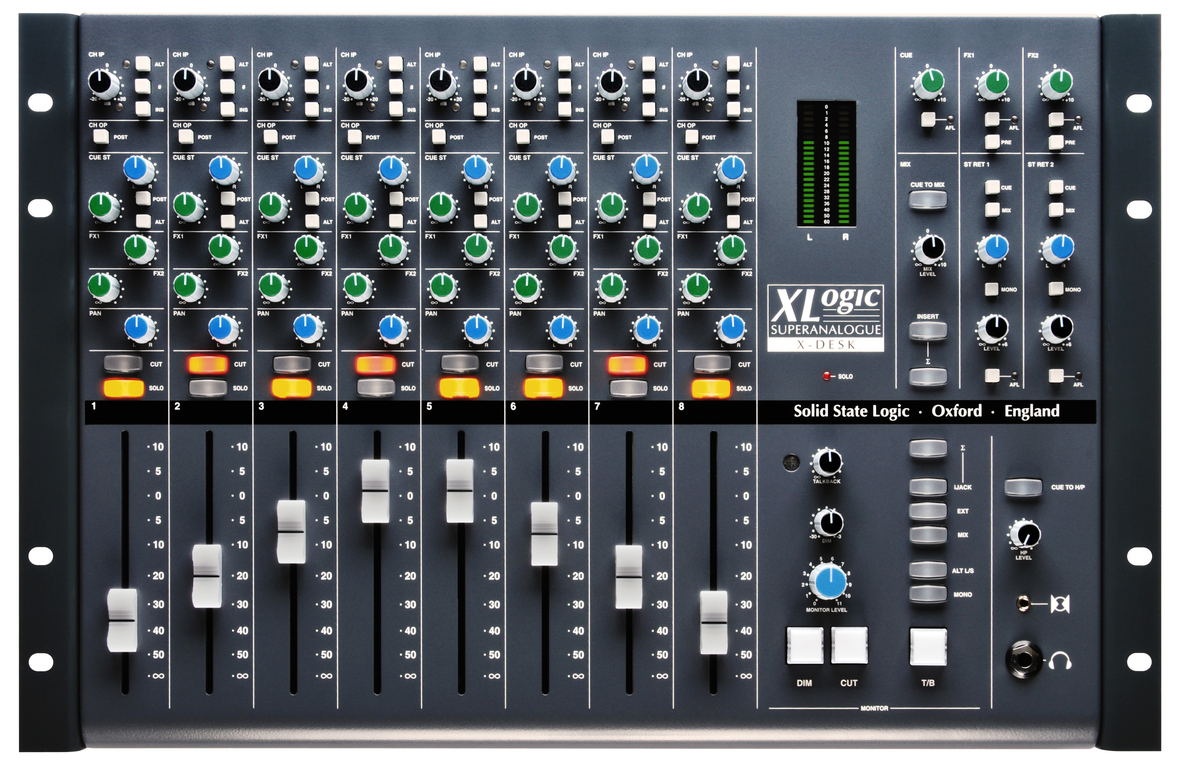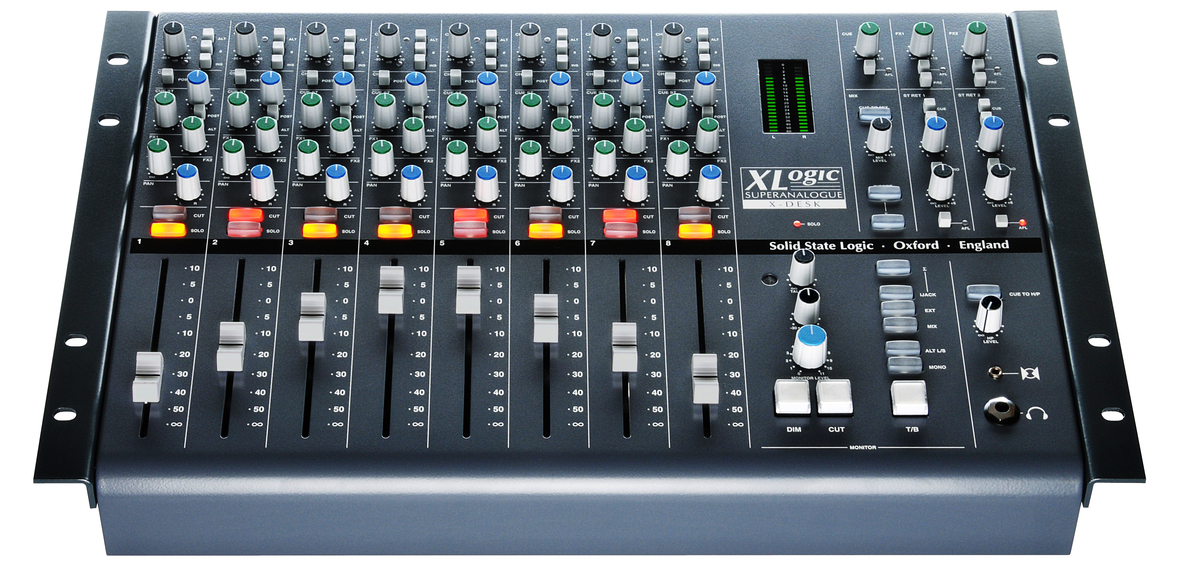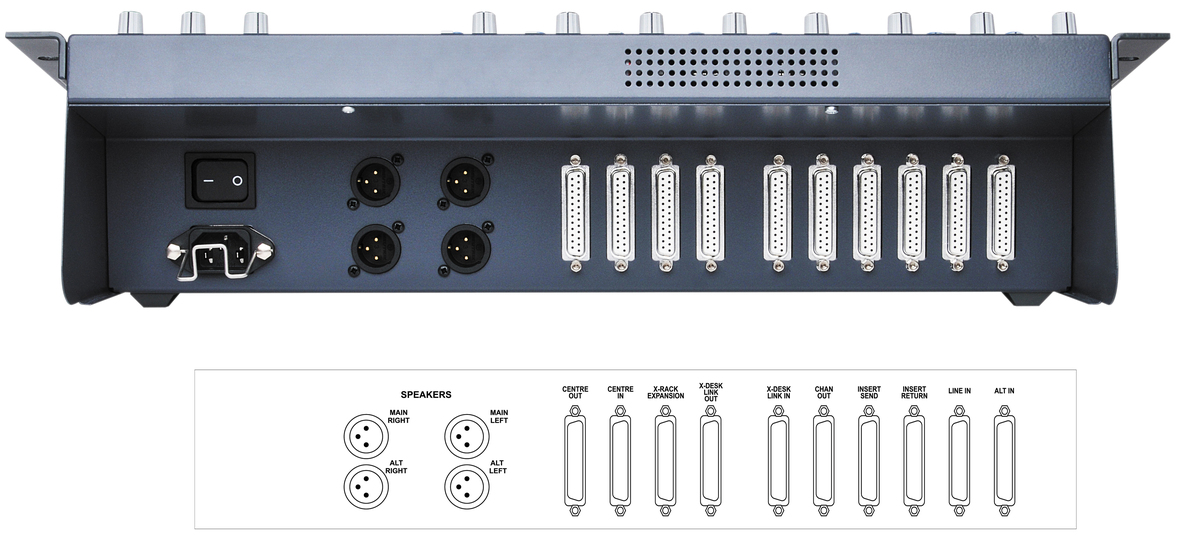
Review by George Shilling
No relation to Monty Python’s Ex-Parrot, nor Nissan’s X-Trail (a derivative of the N-Trail?!), the X-Desk is perhaps an SSL for everyone. Although the price makes it easily the cheapest SSL mixing desk yet, some may be disappointed that there is no recall, no automation, no dynamic control, nor any EQ. But the X-Desk does boast SSL’s excellent SuperAnalogue circuitry, and it’s UK-built, so it should sound as good as a Duality. The feature list says 16 channel mixdown, although a more boastful advertiser might say 20 or 22 – SSL’s count fails to include two stereo Returns, and Mix Insert Returns can also be summed. Furthermore, cascading multiple X-Desks is possible (up to eight of them, you can do the maths…!)
The X-Desk is a compact (1U wide) yet robustly constructed unit. In the box was an installation guide but no operation manual. However, one appeared on the SSL website, so I imagine it will now be included. The metal casing around the eight faders seems spartan but has an industrial no-nonsense feel, and you get the impression it is built to last; it is in no way plasticky. Rack ears are provided for attachment to mount the X-Desk in 7U of rackspace. When set on a flat surface the front panel is raked and there is an enormous hidden recess at the back, with potentially injurious sheet metal edges. This area houses and protects the extensive and unconventional audio connectivity. There are an eyebrow-raising ten DB25 connectors here, arranged sideways.
One of the main strengths of the X-Desk is that there are lots of inputs and outputs, with particular connections for hooking up X-Racks (utilising SSL’s proprietary DB25 wiring) and also for joining multiple X-Desks together. The latter and remaining DB25 connectors are wired using the near-ubiquitous Tascam standard and these cover everything except what SSL describe as Speaker Outputs – two pairs of female XLRs for the left and right of Main and Alt monitor outputs, selected from the master section on the front. The only downside of the comprehensive connection arrangements is that DB25s make a fully labelled patchbay rather more desirable, and although the X-Desk is eminently portable, quick ad-hoc setups are perhaps more difficult to arrange. All that remains here to mention is an IEC mains inlet with useful loop-hook arrangement to avoid it slipping out, and a large rocker switch which is in no danger of being accidentally knocked; it’s stiff to operate, and well hidden in this recess. Legending for all connections is on a stuck-on plastic sheet mounted underneath the top panel which is not the easiest thing to read in situ, although if it’s in a rack and you can physically get behind it then this won’t be a problem. When on a desktop, four large rubber feet prevent scratching underneath.
The long travel Alps faders are light and undamped, a little plasticky and with a little vertical play, but gracefully smooth in operation. Above the faders is a black painted stripe which I guess could be used with a white chinagraph as a scribble strip, but it’s not wide enough for a stripe of masking tape, so I stuck mine on across the bottom of the faders on the curved front edge. Above the faders are latching illuminating Cut and Solo buttons. The centre-detented panpot is located just above – this and all other pots retain the reassuring stiffly damped feel of ‘grown up’ SSL desks. Above this are zigzagged pots for two mono FX Sends, these each boast individual master level, global Pre switching and AFL Solo at the extreme top right of the mixer.

Back on the channel strip, the next section is Cue Stereo, this features level and pan knobs, an individual Post switch (default is Pre-fader) and an Alt button, which sources the signal from an additional alternative set of eight inputs (as opposed to the main channel inputs). Above this is a useful Channel Output Post button, governing whether the individual channel outputs come before or after the main fader. This is great for various scenarios such as enabling fixed recording level while you play with headphone or mix balances, or alternatively riding the faders ‘to tape’. At the top of the strip is a Line In trim pot with +/-20dB gain, and a centre détente at zero. Accompanying this is an Alt button with LED, Polarity reverse, Insert switch (a luxury at this price!) and an LED which is tri-coloured, showing signal present, peak and overload. The faint of heart can globally set the yellow and red to come on a few dBs lower if necessary with a power-up option.
Across from the LED main stereo meters are master Cue level with AFL and the aforementioned FX Send masters, a Master section with rotary Master fader detented at zero (not great for fades), Cue to Mix button, Insert and an interesting Sum button. This merges the main mix with whatever is connected to the main insert return, opening up all sorts of possibilities such as merging summing from any other summing mixer output.
The two stereo Returns are fully featured, each with level and pan, buttons to route to Cue and Mix, a Mono button, and AFL.
A front panel Headphone jack is provided with its own level control and a Cue to HP button. The headphone amp is adequate but I wasn’t entirely convinced that the audio quality was as good as at the main outs, although it’s fine for foldback. Also located here is a stereo minijack ‘iJack’ input socket for iPod connection. In the monitoring section this is one of three sources – Mix and External stereo input being the other two, and here there is another Sum button for monitoring more than one of those simultaneously. Huge buttons are provided for Speaker Dim and Cut, and there is another for Talkback – a mic is built in here, and it has wonderfully severe limiting across it, although I was very disappointed that Talkback was only routed to the Cue mix circuit. Even when switching the FX Sends to Pre for an alternative headphone mix there is no way of getting talkback to those cans, so I think a trick was missed there – this makes talking to a second alternative headphone mix difficult to organise. I’d like to have accessed that bonkers limiter too! There is a knob for Dim level, and also of course a large monitor volume knob going up to the customary 11 setting. An illuminating button is provided for Alt Speakers and there is also a Mono button. All controls in this area are very clear and well laid out, and apart from the lack of a proper master fader, this whole section is excellent.

So how do eight faders become 16 channels at mixdown? As mentioned previously, each channel has a main input but also an Alt input. By depressing the Alt button in the Cue section on each channel, then routing Cue To Mix, both paths can access the mix buss, with the Alt signals level and pan controlled by the Cue settings. Alternatively, the Alt signal can be chosen as the channel’s main signal, thereby gaining access to the sends, channel input trim, and the Solo button of course. Solo is AFL in nature.
In a permanent studio installation, the true flexibility of the X-Desk will only be realised by connecting all the rear panel DB25 connectors to a clearly labelled patchbay. This would give you access to the eight channel inputs, the eight channel outputs, the eight Alt inputs, Channel insert sends and returns, and centre section inputs and outputs including inserts, FX and Cue sends and Returns inputs. The remaining connections are for X-Desk Link input, Link output, and an X-Rack expansion connection, and again this opens up enormous potential for an integrated system with huge numbers of inputs available using multiple input X-Rack modules, or a choice of SSL EQ and dynamics modules. Indeed, the channel layout is arranged such that the modules in an X-Rack mounted above will line up. Clever.
The well-built X-Desk is something of a halfway house between a summing mixer and a fully featured console, and I cannot really think of any competing units which are similarly featured. The summing is audibly superb, clean and clear, with no apparent colouration, just sparkling clarity and plenty of headroom. But the X-Desk has a number of other useful tricks up its sleeve. The lack of recall may be a deal-breaker for some, but the concept is not that far removed from desks like the rather more expensive modular RND 5088. The advantages are perhaps more evident if you already own an X-Rack or two, or if you have a rack of preamps and you need a way of cleanly mixing them down, perhaps for live recordings, setting up a can balance, adding some effects, but not needing the ability to recall the setup.
You probably own plenty of EQs and compressors as plugins, so perhaps these are less essential for this kind of mixer. For overdubbing one could monitor DAW output from a stereo return and use the faders, channel outputs, mix buss and sends for submixing and monitoring the mics or other sources. The X-Desk is so flexible that it is bound to find uses I haven’t dreamed of. The centre section alone makes an excellent monitor controller, and if you fancy a few more features than a typical summing box for not necessarily that much more money, the X-Desk looks extremely attractive. The only downside is that soon, every bedroom studio will be advertising that they have an SSL desk…
Pros: 20 (or more) inputs; SuperAnalogue audio quality; Flexible connection options; Solidly built; Multiple desks can be cascaded; Extensive X-Rack expansion possibilities; It’s an SSL!
Cons: No recall is the main drawback; Not possible to route Talkback to FX Sends
Reproduced with kind permission from www.georgeshilling.com. Copyright ©



